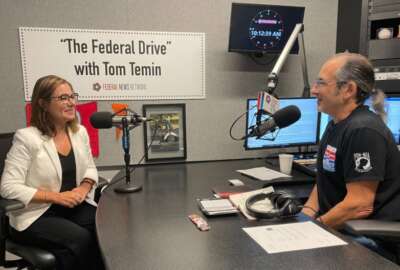Hubbard Radio Washington DC, LLC. All rights reserved. This website is not intended for users located within the European Economic Area.
An old medical product gets a modern makeover thanks to this USDA scientist
Ever get a cut and use cotton gauze to wipe it up? Cotton gauze is just cotton gauze, right? Not to my next guest. He developed new cotton fabrics that have pro...
Ever get a cut and use cotton gauze to wipe it up? Cotton gauze is just cotton gauze, right? Not to my next guest. He developed new cotton fabrics that have proven more effective in trauma care and other medical requirements than the traditional ones. In fact, his invention is the first new medical gauze in 50 years. Federal Drive with Tom Temin spoke with Vince Edwards, a chemist with the Agricultural Research Service and a finalist in this year’s Service to America Medals Program, also known as the Sammies.
Interview Transcript:
Tom Temin Tell us about your work. You don’t ordinarily think of the Agricultural Research Service as coming up with medical solutions, but tell us about your work here.
Vince Edwards Yes, this started about a quarter of a century ago in the late nineties, and I joined a part of the USDA Agricultural Research Service in New Orleans Southern Regional Research Center. And in the mid nineties, following some very fruitful work that was established by several generations of cotton textile chemists, I entered into the Cotton Chemistry Utilization Unit after having a background in pharmaceutical and gene transfer research. And it was at that time that when I entered into the lab, there was an open mindedness about a scientist applying themselves as is there still is today to creative ideas. And my new boss said, Here’s your lab, go to it. And first impulse was to take cotton and apply wound healing concepts to cotton. Doing that involves eventually becoming a collaborator with wound healing scientists, and then on into the future, fast forwarding, working intimately with cotton farmers and manufacturers and marketing individuals to eventually bring products to market for actually both chronic wound care, as well as trauma care.
Tom Temin Sure. And what is it about cotton? What does the newest gauzes and fabrics do that the old ones could not do? And how do you change cotton? That seems like such a basic commodity that’s been around forever.
Vince Edwards Well, historically, cotton has played a role in this country’s history. Interestingly enough, the type of cotton we developed here is not all that new to the scene. It just appears to be, especially when we talk about the trauma care dressings. We employed a type of unbleached cotton in developing those, and that form of cotton actually played an important role in times of battle in the American Civil War. During that period, the production of cotton dressing derivatives, which were referred to as Sharpie, was a national effort. But we developed cotton dressings, fast forwarding then to modern design principles using de novo design. That implies starting at a molecular level about what is known about the composition of the fiber and the cotton fibers is very rich in molecular properties that lend itself to new designs for wound care. So that’s sort of how we got into the design principles of some of these types of dressings.
Tom Temin And right now, the dressing that you have developed is being used by the Marine Corps, correct?
Vince Edwards Yes. They’re very interested in developing this concept further with the idea of applying it to prolonged field care. And so what we developed here was a type of bleeding control dressing that is now used by first responders and available for the armed forces for their use in trauma. And the Marine Corps, along with the Defense Health Agency, has a great interest in developing domestic base products that will serve soldiers in the battlefield. And one area is prolonged field care. And this is an austere in remote parts of the world, such as Afghanistan, where soldiers cannot be evacuated in a 24 hour framework. And you need addressing that not only staunchest bleeding controls, hemorrhages, but also prevents infection. And so taking that another step forward, that’s how we’re working with our brother agencies, the Defense Health Agency, as well as the United States Marine Corps.
Tom Temin We’re speaking with Dr. Vince Edwards. He’s a research chemist at the Agricultural Research Service, and a finalist in this year’s Service to America Medals Program. And in order to get these qualities of infection control and greater absorption and so forth, is the gauze treated chemically or is it somehow in the composition of the way the molecules line up when it’s spun into this particular fabric.
Vince Edwards Right. Well, Tom, we are able to use the natural properties of cotton combined with other fibers to produce what we call pro coagulant activity, and using the principles of de novo design, we have what we call a three point triangular approach. And this includes allowing the fiber to promote clotting through both properties of the fabric, as well as you’ve alluded to components, molecular components in the fiber, and then studying what makes these properties come together as a blood contacting surface to initiate clotting. And actually this has been studied by other scientists and other organizations for some time in the context of bringing dressings for severe hemorrhage control to the battlefield. And that all started as a result of some of the things that happened in the Somalia crisis when the Marine Corps was involved there. And it was clear from some of the injuries and trauma in that engagement that there was needed a severe hemorrhage control type dressing. And so we’re not the first to work on these types of dressings.
Tom Temin Sure. And I guess my other question is, how do you test these new developments in fabrics?
Vince Edwards Well, we employ a device called Thromboelastography in our lab. And this is an instrument that’s used in hospitals to measure clotting. And scientists have adapted it to measuring what we call hemostatic properties of different types of biomaterials. And so we adapted this to measuring cotton fabrics, ability to initiate clotting. And so over a period of years, we developed some insights as to how to both use this instrument and design fabrics so that we could discern different properties in the fabrics that would initiate clotting. And so that was really the instrument that we first discovered the ability of unbleached cotton to promote clotting.
Tom Temin Interesting. Does it ever surprise you that thousands of years after the Egyptians discovered cotton and so forth, there’s still more to be learned about this commodity?
Vince Edwards Oh, definitely, yes. Cotton as many interesting properties that lend itself to new discovery. Certainly our center is known for some of those as well. The American Chemical Society historical landmark awarded on Center for its discovery of flame retardant and permanent press cotton going back into the late fifties, early sixties when King Cotton was threatened by synthetic fibers. And then during World War II, a cotton textile chemist by the name of Dr. Charles invented Stretch cotton here at our center. It’s sort of a household thing. It has been for years, but before stretch cotton rubber was used in cotton to make the stretch occur.
Tom Temin They used to call steel the miracle metal, maybe we should call cotton the miracle fabric.
Vince Edwards That’s right. It’s certainly something that we continue to develop new ideas and we are in the process of working with the Marine Corps and other organizations to develop a family of dressings that addresses not only trauma care, but burn wound care and using other components of the cotton fiber, something called nano cellulose that we can extract from cotton is another avenue that opens up new potential applications.
Copyright © 2024 Federal News Network. All rights reserved. This website is not intended for users located within the European Economic Area.
Tom Temin
Tom Temin is host of the Federal Drive and has been providing insight on federal technology and management issues for more than 30 years.
Follow @tteminWFED





